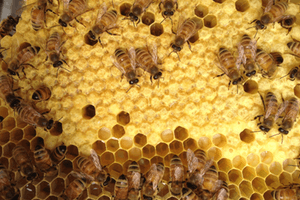- All-In-One Beekeeping for the Bees
- +1-608-728-8233
- info@beepods.com
What Your Bees Are Up to This Fall and How You Can Support Them


September and October are busy months for your bees. They’re working hard to prepare the hive for the cold to come, and you’re probably noticing some changes in their behaviors and activities. Today we’ll discuss what your bees are up to this fall, and how you can support their efforts to prepare for the winter ahead.
Adjusting to Fall Weather
While there are still some warm and summery days to enjoy, cooler temperatures are quickly sneaking into the forecast and reminding us it’s officially fall. Sign up for next month’s Honey Do Monthly Beekeeping Checklist to make sure you’re taking every necessary step to winterize your hive and prepare for the icy temperatures to come.
As colder days become the norm, you’ll observe worker bees upping their propolis game. They’ll use the sticky substance to seal and protect the hive from chilly drafts and dropping temperatures. When it gets colder, the bees work together to cluster and keep the hive warm. Sealing up the hive is the bees’ way of making sure no cold air gets in while they’re trying to heat things up.
Check your hive’s vents and open your Beepod’s vent board as needed. Ensuring that the hive is well ventilated reduces the chances of moisture build-up. That clustering they’re doing to warm the hive creates moisture. Without proper ventilation, your bees could die from being wet and cold, or the hive could become a host to mold, fungus, or spoiled honey stores.
A Changing Population
As mating months come to an end and your colony prepares for the winter, the population inside your hive will change. The queen is just about done with laying eggs, and while it might be tempting to check on the brood, you’ll want to avoid doing so at this time of year. You can find out more about this by checking out the October Honey Do List!
The circle of life (cue “The Lion King” soundtrack) is underway, and older bees are dying. And the drones… well, their time is up, too. Drone bees don’t contribute anything to the hive, aside from mating. So, the ladies kick those guys to the curb around this time of year.
You might witness guard bees blocking drones from the hive. Sometimes workers will even team up to drag drones out of the hive, or chew on their wings and harass them until they can’t take it anymore. It might sound a bit cruel, but worker ladies are serious about saving winter food stores!
Preparing Honey for Winter
Comb production is slowing down, and your bees are shifting gears to their main priority: preparing food stores for winter. They’re focused on producing lots of honey, and they should be! Depending on where you’re located and how many bees you have, it can take up to 90 lbs of honey for them to survive the winter.
If it doesn’t seem like your bees are making enough honey, this is when you can help them with supplementing feeding or removing bars to encourage production. Make sure to save any honey you’re storing for them in a Beepods Harvest Box, so it stays fresh and secure.
As the bees (hopefully) are diligently cranking out honey, they build their bars wider, and you might discover some are touching. Mark those connected bars with a Sharpie so you can move them as one during hive inspections. You can also use spacers as needed.
Dealing with Unwanted Visitors
While your bees are busy keeping things warm in the hive and preparing their food stores this fall, other animals might be seeking comfortable accommodations. October is prime time for small critters like mice to set up shop in your hive, much to your and your bees dismay.
Now is an excellent time to put precautions into place to deter unwanted visitors and protect your bees. Click here for steps to help you keep mice and other little rascals away from your bees’ hard-earned heat and honey.
Conclusion
A lot will be changing for your bees in the next month! They’re getting ready for the cold, their colony makeup is changing (those poor drones), and they’re taking measures to ensure they have a well-fed winter. Make sure you subscribe for the October Honey Do Beekeeping Checklist to be confident you’re doing everything you can to help your bees with their preparations.
Kanoe Riedel
Latest posts by Kanoe Riedel (see all)
- This Spring, Don’t Forget Why Bees Are So Important to Our Environment - March 26, 2021
- 11 Awesome Uses for Your Stored Honeycomb - March 2, 2021
- How the Right Beekeeping Equipment Makes Inspections Better for Beekeepers and Bees - February 12, 2021
Kanoe Riedel
Related posts
The Bee Enclosure Module (BEM) was an aluminum box designed to hold over 3400 worker bees and one queen for the student experiment "A Comparison of Honeycomb Structures Built by Apis millifera (SE82-17)." Investigators studied the effects of microgravity on the comb building activities of honeybees.



